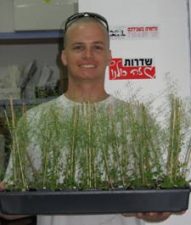 Lotus flowers were once considered sacred in Egypt and parts of Asia. They hold a secret to a clean nanotechnology.
Lotus flowers were once considered sacred in Egypt and parts of Asia. They hold a secret to a clean nanotechnology.
Like the ancient blue pigment found in ancient Egypt, old spiritual materials like the lotus flower inspire new environmental science: As assistant professor of Environmental Sciences and Engineering at King Abdulla University of Science and Technology (KAUST), Dr. Peng Wang seems to embody this Saudi Arabian university’s motto, “Through Inspiration, Discovery.” His research focuses on the possible uses of environmental nanomaterials in order to solve three of the biggest environmental problems of our time; water scarcity, energy production and pollution.
Wang seems to enjoy the fine tuning of the size and form of these tiny materials in order to solve what sometimes seem to be intractable environmental problems.
He says, “on a personal note, there is always a lot of fun working with these very tiny materials.” Who wouldn’t enjoy studying the lotus effect, pore size modulation and superhydrophobicity? The following is a brief explanation of how environmental nanomaterials can help solve real-world problems.
The field of nanomaterials is concerned with the unique properties of materials which come from their nanoscale features, that is– features from 1 to 100 nanometers in size. A lump of coal, graphite, soot, diamond and graphene are all forms of carbon which behave very differently because of the way the carbon atoms are arranged. Environmental nanomaterial science is focused on manipulating these materials at this scale in order to solve environmental problems.
Clean Hydrogen Energy from Sunlight
Professor Wang’s group is working on making one-dimensional anodized nanostructures out of Titanium Dioxide and Copper Oxide. These materials may be used in photocatalysis applications where sunlight provides the energy to separate hydrogen gas from water. He has designed cells where the hydrogen gas is generated at the same time as contaminants are decomposed through oxidation.
Superhydrophobicity
No, I didn’t make that word up the word superhydrophobicity though I wish I had. And no, it isn’t something you vaccinate your dog against. Superhydrophobicity is the nanoscale property responsible for what is known as the lotus effect. The lotus flower plays a key role in some of the ancient Egyptian creation myths and is considered a symbol of purity in parts of Asia. Lotus plants often grow in muddy water but their leaves and blossoms are always clean. Tiny folds and bumps and other nanoscale structures on the plant create a superhydrophobic effect which prevents water from wetti ng the surface.
ng the surface.
Typically waxy surfaces such as lotus leaves can cause water’s surface tension to pull it into flat or hemispherical beads, but the lotus’s superhydrophobic effect goes beyond this. The water is so afraid of the plant’s bumpy surface, it pulls itself into tiny balls which roll off carrying away the dirt. This property has already been exploited in the form of self-cleaning paint.
Wang believes this property can also be used to purify water by separating water from salt, oil and other contaminants. By changing the size of the nanostructures (in this case pores) in a material, it is possible to change its surface wettability.
This so-called pore size modulation has applications in water purification and in extracting water from air. Professor Wang’s group has already developed a smart material which could be switched from an oil attraction mode to an oil repulsion mode. They are currently in the process of scaling up this material as a step in its application outside of the laboratory.
Photos of Egyptian women with lotus flowers and water drop on a lotus leaf via Shutterstock


